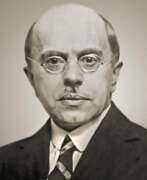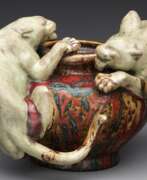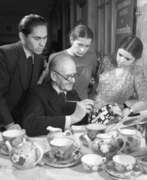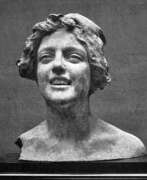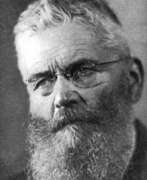Ceramists 19th century


Charles Garabed Atamian is a French artist of Armenian origin born in Turkey.
He studied for a time at the Academy of Fine Arts in Venice, then worked as chief designer at a porcelain factory in Istanbul. In 1894, Atamian worked with a team of artists to decorate the new palace of Sultan Abdul-Hamid Il in Yildiz, on the European side of the Bosphorus. He designed, among other things, the patterns for the ceramic tiles of the palace walls.
In 1897, Atamian emigrated to France and began illustrating books and magazines, as well as working on sets for several Parisian theaters. Since 1903 Atamian participated in various exhibitions with unquestionable success. He painted landscapes, sea and beach scenes with children (including some 200 paintings at Saint-Gilles in the Vendée, where he resided each year during the summer months from 1923 to 1939). Throughout his career he was a fine portrait painter. He became a member of the National Society of Artists in 1927.


Jean-Jacques Bachelier was a French painter and innovator of porcelain and a member of the Royal Academy of Painting and Sculpture.
Originally a still-life painter, he later became world-renowned for his significant contributions to applied art. In 1765, Bachelier founded an art and crafts school in Paris with his own funds. He was in charge of the painters at the porcelain manufactory in Vincennes, where figures were produced from unglazed porcelain - biscuit. For many years Bachelier was the Director of Sevres porcelain manufactory and in fact became the creator of the Sevres style.
Bachelier also conducted research on encaustic painting (a painting technique in which the binding substance of paints is wax) and published works on art education.


Hans Christiansen was a German painter, representative of classical modernism, decorator and illustrator.
Christiansen trained as a decorative painter in Flensburg and then at the School of Applied Arts in Munich, later studying at the Académie Julian in Paris. After a study trip to Italy in 1889, he moved to Hamburg, where he taught at the Technical University.
At the same time, Christiansen worked as a freelance decorative artist and was active in the Volkskunst-Verein, and was one of the founders and first residents of the Darmstadt artists' colony of the late 19th and early 20th century. Together with Josef Olbrich and Peter Behrens, he designed furniture, ceramics, tapestries, stained glass and graphic posters. He also designed his own house in the colony, which he called "Villa Rose," which was destroyed during World War II.
During this time, the versatile artist also wrote regularly for the magazine Jugend, creating many illustrations and covers. From 1911 he lectured at the Wiesbaden School of Arts and Crafts and was a member of the Wiesbaden Free Artists Association.
In 1933, Christiansen's work was banned by the Nazi Party of Germany because of his Jewish wife, and he was almost forgotten until his death in 1945.




André Derain was a French artist, renowned as a painter, sculptor, and a pivotal figure in the development of Fauvism alongside Henri Matisse. Born on June 10, 1880, in Chatou, Yvelines, just outside Paris, Derain's artistic journey began in his youth. Despite initially studying to become an engineer, his passion for art led him to the Académie Julian and to acquaintances with notable artists like Matisse and Maurice de Vlaminck.
Derain's work, especially his paintings, is celebrated for its vibrant, expressive use of color and innovative compositions. His contributions to Fauvism, a movement characterized by the use of bold, non-naturalistic colors, marked a significant shift in the art world. The Fauvist period, particularly his collaboration with Matisse in the summer of 1905 in Collioure, culminated in works that were distinguished by their startling hues and wild brushwork, earning them the nickname "the wild beasts" or "les Fauves."
A notable period in Derain's career was his time in London in 1906, commissioned by art dealer Ambroise Vollard. His London series, including views of the Thames and Tower Bridge, are celebrated for their unique perspective and use of color, differing significantly from the traditional depictions of the city by artists like Whistler or Monet. These works stand out for their Pointillist influence and the effective conveyance of light and movement.
Derain's artistic evolution continued as he experimented with Cubism and was influenced by African art, as seen in his primitivist woodcuts for Guillaume Apollinaire's book "L'enchanteur pourrissant" (1909). His career, however, was not without controversy, particularly during World War II, when he was perceived as a collaborator due to his interactions with the Germans.
Despite the challenges and transformations in his career, André Derain left an indelible mark on the art world. His works are held in prestigious collections worldwide, including the Musée Cantini in Marseille and the Musée d'art moderne de Troyes. Derain's contribution to modern art, particularly through Fauvism, remains a subject of admiration and study among art collectors and experts.
If you're captivated by the artistic journey and pioneering spirit of André Derain, don't miss the opportunity to stay updated on his legacy. Sign up now to receive exclusive alerts on new product sales and auction events related to André Derain's work. Embrace your passion for art and culture, and ensure you're always informed about the latest offerings and unique pieces linked to this iconic artist.


Alfred William (Willy) Finch was a ceramist and painter in the pointillist and Neo-Impressionist style. Born in Brussels to British parents, he spent most of his creative life in Finland. In 1883 he became a founding member of Les XX, a group of twenty Belgian painters, designers and sculptors, who rebelled against the prevailing artistic standards and outmoded academism. He was impressed by the works of Georges Seurat and Paul Signac and changed his own painting style from a more realistic approach into a pointillistic style. In the following years, Finch became one of the leading representatives of his style in Belgium, along with Théo van Rysselberghe. During the early 1890s Finch switched careers from painting to pottery, upon the realization that he couldn't make a living by painting. In 1897, invited by count Louis Sparre, Finch moved to Porvoo, Finland, to head the Iris ceramics factory, and influenced the development of the local Jugendstil. After the factory was closed, Finch resumed his painting career.


Emile Gallé was a French artist and designer who worked in glass, and is considered to be one of the major innovators in the French Art Nouveau movement. He was noted for his designs of Art Nouveau glass art and Art Nouveau furniture, and was a founder of the École de Nancy or Nancy School, a movement of design in the city of Nancy, France.


Paul Gauguin, a French artist born in Paris in 1848, is renowned for his significant contributions to Post-Impressionism, Primitivism, and Synthetism. Gauguin's art is distinguished by his experimental use of color and style, which set him apart from the traditional Impressionist movement.
Gauguin's early life was marked by a period in Peru, which influenced his artistic perspective. Initially, he pursued a career in stockbroking but soon turned to art, driven by financial necessity and a growing passion. His artistic journey began under the mentorship of Impressionist artist Camille Pissarro and through exposure to the works of other avant-garde artists.
The hallmark of Gauguin's work is his exploration of non-Western cultures, particularly during his time in Tahiti and the Marquesas Islands. This period saw the creation of some of his most famous works, including "Where Do We Come From? What Are We? Where Are We Going?" His paintings from this era, characterized by vivid colors and Symbolist themes, reflect a fusion of cultural influences and his quest for a "primitive" expression of spiritual and emotional states.
Despite his innovative style, Gauguin struggled with financial difficulties and health issues throughout his life. His work received little recognition during his lifetime, but posthumously, he gained acclaim for influencing modern artists like Pablo Picasso and Henri Matisse.
Today, Gauguin's works are celebrated in galleries and museums worldwide for their unique blend of cultural influences and artistic innovation. His enduring legacy is a testament to his unique vision and the profound impact he had on the art world.
Collectors and experts in art and antiques, stay updated on new product sales and auction events related to Paul Gauguin. Sign up now for exclusive updates and immerse yourself in the world of this visionary artist.


Johann Heinrich Hintze was a German painter of the mid-nineteenth century. He is known as a master of landscape and architectural painting and is considered one of the leading German architectural painters of his time.
Heinrich Hintze was commissioned by the Grand Duke of Mecklenburg-Schwerin in the early 1820s, then concentrated on architectural landscapes of Berlin and its environs. His artistic legacy includes landscapes and architectural views from Holstein, the Alps, Vienna, Prague and elsewhere. The master paid special attention to cityscapes, using both oil and watercolor.


Joseph Fernand Henri Léger was a French artist renowned for his innovative approach to Cubism and his transition towards a figurative, populist style. Born in Argentan, Orne, Lower Normandy, Léger's early career was marked by a stint as an architectural draftsman and a series of educational pursuits that eventually led him to Paris, where he embraced painting seriously. His artistic journey was significantly influenced by the bold abstractions of Cubism, characterized by geometric shapes and a vibrant palette, distinguishing his work from his contemporaries with what came to be known as "Tubism".
Léger's service in World War I profoundly impacted his artistic direction, leading him to adopt a 'mechanical' style that depicted the modern industrial world with sleek, tubular forms. This period saw creations like "Soldier with a Pipe" and "The Card Players," reflecting his war experiences and the mechanical aesthetics of the time. The post-war era encouraged Léger to explore the mechanical style further, evident in works like "The Bargeman" and "Mechanical Elements," highlighting the pace of technological advancement.
Throughout his career, Léger's work evolved, notably in the 1920s, where he aligned with Purist ideas, blending classicism with modernity. This phase is exemplified in "Woman with a Cat," showcasing a classical form with a modern, polished finish. By the 1930s, Léger's art took a more figurative, populist turn, aiming to democratize contemporary art and make it more accessible. His commitment to art education, especially for the common worker, underscored his belief in the social role of art.
For those intrigued by Joseph Fernand Henri Léger's groundbreaking contributions to modern art, his works can be found in prestigious museums worldwide. His legacy continues to inspire art collectors and enthusiasts alike. To stay updated on exhibitions and auction events featuring Léger's work, sign up for updates and embrace the unique opportunity to explore the richness of his artistic endeavors.


Georges Lemmen is a Belgian Neo-Impressionist painter, member of the XX Society. He was close to art from childhood and studied for a time at a special drawing school. In the early 1880s, as a teenager, he was introduced to the work of Edgar Degas and Henri Toulouse-Lautrec, which had a great influence on him.
Georges Lemmen's paintings were marked by the use of fine, clean strokes and a vivid colour palette. He used the technique of divisionism, applying strokes of pure colour in close proximity to one another to create a sense of optical blending and luminescence.
Lemmen's subject matter was varied: landscapes, portraits, interiors and scenes of everyday life. He often portrayed leisurely pursuits and the beauty of nature, infusing his work with a sense of tranquillity and harmony.
Until 1895, he abandoned pointillism to contribute to the development of Belgian Art Nouveau. He created many book illustrations, posters, ceramics, carpets, drawings, pastels and gouaches in this style.


Clara Augusta Amalie Emma Lobedan is a German painter and ceramist.
She studied painting in Berlin and became known for her exquisite still life and ceramic works. Lobedan painted in oils, watercolors, and pastels, and regularly participated in various exhibitions around the world.
Lobedan also directed the Women's Painting School and the Studio for Artistic Domestic Ceramics in Berlin.


Louis Majorelle was a prominent French artist, cabinetmaker, furniture designer, and a leading figure of the Art Nouveau movement. Trained initially as a painter, Majorelle shifted focus to furniture design, taking over his family's business and emerging as a dynamic force within the École de Nancy.
Louis Majorelle was instrumental in the Art Nouveau style's development, known for his innovative and nature-inspired designs. He was one of the founding members of the École de Nancy, a collective that aimed to promote Lorraine's decorative arts. Louis Majorelle's work, particularly in furniture and interior design, showcased his skill in integrating natural forms with functional pieces. His use of materials such as mahogany and his incorporation of floral and organic motifs were distinctive of his work. Notably, Majorelle's Nénuphar bed, displaying water lily motifs, stands as a testament to his design philosophy and can be seen at the Musée d'Orsay in Paris.
The Villa Majorelle, his own residence in Nancy, serves as an embodiment of Art Nouveau architecture, featuring intricate ironwork and woodwork crafted by Louis Majorelle himself. This house not only served as his home but also as a beacon of Art Nouveau's architectural potential, showcasing the movement's aesthetic in a living environment.
For collectors and experts in art and antiques, Louis Majorelle's work represents the pinnacle of Art Nouveau's embrace of naturalistic designs and the seamless blend of art and craftsmanship. His contributions to the movement have left an indelible mark on the history of decorative arts.
To stay informed about new discoveries and interpretations related to Louis Majorelle and his era, signing up for updates is highly recommended. This subscription will ensure you're alerted to new product sales, auction events, and exhibitions related to this significant figure in art and design history.


Joan Miró, a celebrated Spanish artist, was a master in painting, sculpture, and ceramics, renowned for his unique style that blurred the lines between Surrealism, Fauvism, and Expressionism. Born in Barcelona to a family of a goldsmith and a watchmaker, Miró grew up immersed in the rich cultural heritage of the Barri Gòtic neighborhood. His artistic journey began with drawing classes at the age of seven and continued at the prestigious La Llotja art academy. Despite an initial venture into the business world, Miró's passion for art prevailed, leading him to abandon his clerical career after a nervous breakdown.
Miró's work is noted for its exploration of the subconscious, often depicting a childlike perspective. This approach was both a critique of traditional painting methods and a means of expressing Catalan pride. His art, challenging to categorize, often featured symbolic elements and nationalistic qualities. One of his notable early works, "The Farm," reflects a transition to a more individual style, blending elements of his Catalan roots with broader artistic influences. This piece, later purchased by Ernest Hemingway, encapsulated the essence of Spain in its imagery.
In Paris, Miró joined the Surrealist movement in 1924, where his work began to reflect the influence of automatism, emphasizing spontaneous, automatic, or subconscious creation. He experimented with various mediums, including painting-poetry and collage, and even ventured into set and costume design for Sergei Diaghilev's Ballets Russes.
During World War II, Miró remained in Spain, and his work from this period, including the 22 Constellations series, reflected an interest in the night, music, and stars. His forms became increasingly abstracted, and he experimented with various techniques, often incorporating primary colors and evocative titles.
Miró's career spanned several decades, during which he continually evolved his style and explored new mediums. His contributions to art were recognized with numerous awards and retrospectives, including a major career retrospective at MoMA in 1941 and the Spanish Gold Medal for Fine Arts in 1980. Among his last major works was a tapestry for the World Trade Center in New York City, created in 1974.
For art collectors and enthusiasts, Joan Miró remains a figure of immense interest, not only for his distinct style and contributions to Surrealism but also for his ability to blend poetic imagery with political commentary. To stay updated on new product sales and auction events related to Joan Miró, sign up for our updates and immerse yourself in the world of this extraordinary artist.


Pablo Ruiz Picasso, a Spanish artist renowned for his revolutionary contributions to the 20th-century art scene, is a figure that resonates profoundly with collectors and art experts. His unique blend of talents in painting, sculpture, printmaking, and ceramic art, infused with his time in France, positioned him as a pivotal character in modern art history.
Picasso's artistic journey was marked by distinct periods, each showcasing his evolving style and genius. His early years were characterized by the Blue Period (1901-1904), followed by the Rose Period (1904-1906), and then the African-influenced Period (1907-1909). Picasso's name is synonymous with Cubism, a movement he co-founded, which significantly altered artistic perspectives and methods. Works like "Les Demoiselles d'Avignon" (1907) and "Guernica" (1937) are emblematic of his cubist legacy, the latter being a poignant anti-war statement that remains influential.
His later years saw a return to more traditional styles, with neoclassical and surrealist influences becoming evident. Works from these phases reflect a deep engagement with mythological themes, as seen in "Faun with Stars" (1955), symbolizing his late-life romance with Jacqueline Roque, his second wife.
Picasso's prolific output and innovative spirit made him a legend in his own time, a status that only grew after his death. His works, housed in major museums and private collections worldwide, continue to captivate and inspire.
As a collector or expert in art and antiques, staying informed about Picasso's works, their auction events, and sales is essential. To stay updated on the latest developments and opportunities related to Pablo Picasso, sign up for our specialized updates. Rest assured, this subscription will focus solely on new product sales and auction events pertaining to Picasso's art, ensuring that you receive only the most relevant and valuable information.


Harald Slott-Möller (Danish: Harald Slott-Møller) or Georg Harald Slott-Möller was a Danish symbolist painter.
He received his artistic education at the Royal Danish Academy of Fine Arts. As an adherent of the symbolist direction of painting in Denmark, together with his wife Agnes Slott-Möller, he participated in the creation of the Free Style group. Harald was also a master painter of porcelain and earthenware and worked as a designer at the earthenware factory Aluminia.


Marc-Louis-Emmanuel Solon, pseudonym Miles, was a renowned French porcelain artist. After beginning his career at the Sèvres Porcelain Factory, he moved to Stoke-on-Trent in 1870 to work at Mintons Ltd, where he became the leading exponent of the technique of ceramic decoration called pâte-sur-pâte. His work commanded high prices in the late Victorian period.


Serafim Nikolaevich Sudbinin (russian: Серафим Николаевич Судьбинин), born Golovastikov (Головастиков), was a Russian actor, painter and sculptor.
Serafim came from the merchant family of Golovastikov, his grandfather was an icon painter. In the 1890s he worked as an actor in provincial theaters, in 1898-1904 - in the Moscow Art Theatre, playing several significant roles in the plays of Gorky, Leo Tolstoy and others. In the theater he performed under the pseudonym Sudbinin. In the same years he began to engage in drawing, modeling, photography. In 1902 Sudbinin made a trip to Paris, where he decided to seriously engage in sculpture and soon left the theater.
Since 1904 he has lived permanently in Paris, receiving a scholarship from S. T. Morozov, studied under the guidance of L. S. Sinaev-Bernstein and J.-A. Enzhalber. In 1906 he became a pupil and assistant of the great sculptor Auguste Rodin. Several portraits of Rodin by Sudbinin are kept in the Rodin Museum in Paris. Sudbinin created many portraits and sculptures of famous people in bronze, marble and plaster. In 1913 he executed for the Imperial Porcelain Factory figures of artists T. P. Karsavina, L. V. Sobinov, K. S. Stanislavsky in the role of Stockman, Anna Pavlova in the roles of Bacchante, Giselle, Swan.
After 1917 Sudbinin remained in France. For many years he collaborated with Sevres manufactory and with the workshop of L. Delashënal. Delashënal. Later he had his own workshop in Sevres, where he created decorative vessels, was engaged in fine plastic art in the Art Deco style, in particular, performed figures of animals. Several works by Sudbinin in different years were acquired by the Museum of Ceramics in Sevres and the Museum of Decorative Arts in Paris.
Since 1922 Sudbinin often visited the United States, where he had many orders, in particular created a series of park sculptures for the Minister of Finance E.-U. Mallon. He also turned to religious themes, creating wooden sculptures, stylized in the spirit of early Gothic, with the use of colored varnish and gilding; he was fond of Oriental ceramics and the artistic culture of the Aztecs.


Bart van der Leck was a Dutch painter and designer. He was a member of the De Stijl movement, a group of artists and designers who sought to create a new visual language that reflected the modern era.
Van der Leck began his career as a decorative painter, working on a variety of projects including murals and stained glass windows. He later turned to painting, creating abstract compositions characterized by bold, flat areas of color and simple geometric shapes. His work was influenced by his interest in the visual language of non-Western art, as well as by the work of Dutch painters such as Piet Mondrian and Theo van Doesburg.
In addition to his work as a painter, van der Leck was also a designer, creating textiles, furniture, and ceramics. He believed that art should be integrated into everyday life and worked to create designs that were both functional and aesthetically pleasing.
Van der Leck's work played an important role in the development of the De Stijl movement, and he worked closely with other members of the group, including Mondrian and van Doesburg. His paintings and designs continue to be celebrated for their bold simplicity and their contribution to the development of modern art and design.










